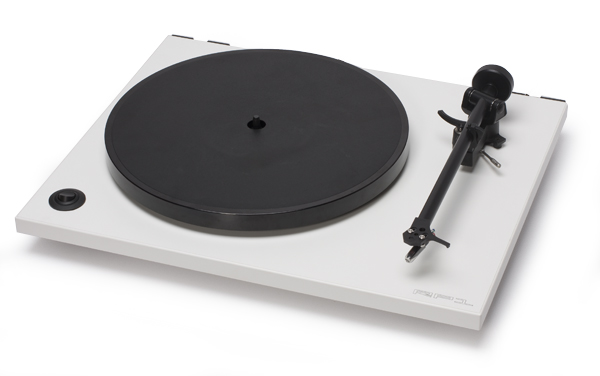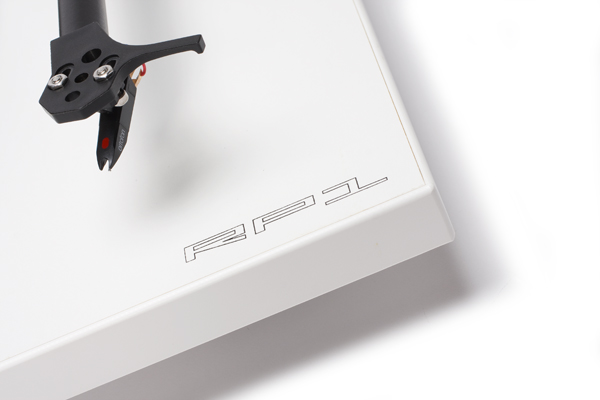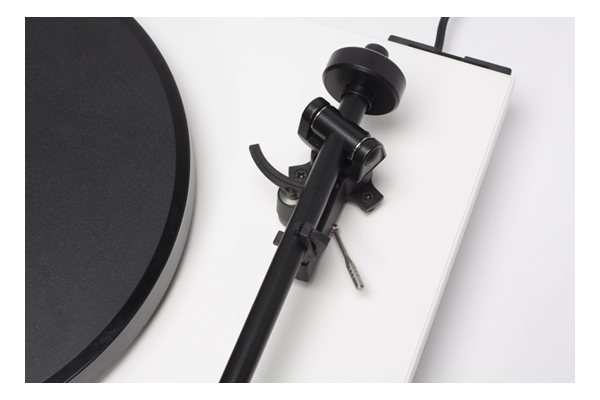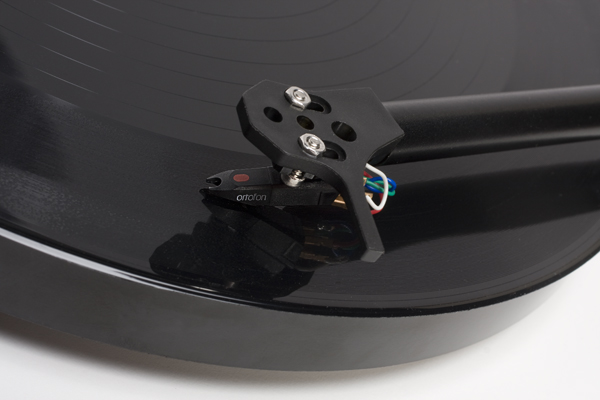Exclusive-The Rega RP1 Rega holds the line on price and offers a major performance upgrade
By Jeff Dorgay Rega met the budget turntable challenge in 2006 with their entry-level P1 turntable, offering the budding vinyl enthusiast a way to join the Rega camp with a brand new table and Ortofon OM5e cartridge for only $400. While Rega has always been one of the best values going in turntables, inflation and world currency markets have taken their toll everywhere. I remember purchasing my first Planar 3 turntable (back in 1979, without cartridge) for $389. Those were the days.
Rega met the budget turntable challenge in 2006 with their entry-level P1 turntable, offering the budding vinyl enthusiast a way to join the Rega camp with a brand new table and Ortofon OM5e cartridge for only $400. While Rega has always been one of the best values going in turntables, inflation and world currency markets have taken their toll everywhere. I remember purchasing my first Planar 3 turntable (back in 1979, without cartridge) for $389. Those were the days.
The P1 was a strong seller, though the table did draw criticism for its MDF platter, which did not yield the best wow and flutter specs. Many P1 owners spent an additional $65 and quickly upgraded to the glass platter that used to come on the older versions of the P2, with a definite improvement.
Rega founder Roy Gandy is a mechanical engineer to the core and is always looking for a way to improve his products. When I visited the Rega factory last summer and again this spring, Gandy made it a point to tell me how much thought goes into his entry-level turntable. (Though he wasn’t spilling the beans about the RP1 in March…) “Every fifty cents that you spend at this price point is a challenge, and it’s always a great exercise to see just how much performance can be incorporated into the final design.”
Enter the RP1 four years later than the introduction of P1 and with only a $50 increase in MSRP; this table is a massive improvement. In all aspects the RP1 is now on par with the P2, but more about that as we continue… Now I know why Roy Gandy’s Acura NSX has a heavy layer of dust on it, he’s been spending a lot of late nights in the lab.
Keeping it simple
Rega has always stood for simplicity, but in recent years, they’ve added some stylish finishes to their turntable range, especially the P3 models that are available in a rainbow of colors. For the RP1, they stripped it to the bone, and have three finishes available; white, grey and platinum, which looks like white with just a tinge of grey mixed in.
There is no external power supply like the P3-24, which allows the turntable speed to be changed at the push of a button. If you want to spin 45’s, you’ll have to take the platter off and move the belt manually to the other groove on the pulley, just like in the old days. The new RB101 tonearm uses a three point mounting platform, just like the rest of the Rega tonearm range, and utilizes composite materials as in the RB301 arm.

Unbox and go… almost
There’s no easier turntable on Earth to set up than the RP1. It comes with the cartridge already mounted. Breaking out the Clearaudio test record and portable strobe showed the speed to be spot on at 33 r.p.m. The OM5e has a tracking force range of 1.5-2.0 grams with a suggested tracking force of 1.75 grams. If you slide the counterweight all the way up to the ridge at the back of the tonearm, you will have a tracking force of 1.8 grams. Bias/antiskate was left at the factory setting of just over one gram and I was spinning my first record in about five minutes. This is the perfect table for vinyl newcomers; anyone can set it up.
In my hurry to start spinning records I did notice some inner groove distortion on the first few records I played. Checking the cartridge setup with MoFi’s Geo Disc revealed that the alignment was indeed off a tiny bit. I’ll chalk that up to being bounced around on a variety of carriers between the UK and my doorstep. However, a quick adjustment was all it took to put things right and five minutes later I was back to Neil Young.
The sound and some comparisons
Having owned every turntable Rega has produced so far except for the P7, the lineage was apparent as I played the first track. The RP1 has a substantial helping of the “Rega Sound”, with speedy attack, and a clean midrange. I had saved some 24/96 digital samples of playback from the P1 (courtesy of my Nagra LB digital recorder) and there was no mistake that the RP1 is a major step up. Listening to samples of both turntables playing selections from The Netherlands Wind Ensemble’s Beethoven Wind Music, the dramatic reduction in wow and flutter in the new table was instantly apparent. Flute and oboe had a woodier, more solid texture to them. In case you don’t have a copy of this record around, a more accessible selection would be Jethro Tull’s “Song for Jeffrey” from their Living In The Past album. You should be able to draw the same conclusion with Ian Anderson’s flute playing.
 The combination of an improved platter and bearing are a big hit on the RP1. Listening to samples from both tables on the MoFi edition of Genesis’ Trick of the Tail had the RP1 again trumping the P1 in bass weight on “Squonk” and HF definition and delicacy on the title track. Cymbals definitely had a smoother decay on the RP1 as well.
The combination of an improved platter and bearing are a big hit on the RP1. Listening to samples from both tables on the MoFi edition of Genesis’ Trick of the Tail had the RP1 again trumping the P1 in bass weight on “Squonk” and HF definition and delicacy on the title track. Cymbals definitely had a smoother decay on the RP1 as well.
Borrowing a friend’s P2 with an identical OM5e installed, allowed for a real-time comparison. The ARC REF Phono 2’s identical inputs, gain and loading could be set identically for both tables allowing a rapid switch between them, minimizing aural memory losses. I was also able to compare the RP1 with the standard platter and the glass platter of the P2. Since Rega is discontinuing the P1 and the P2 in favor of the RP1, feeling that it provides comparable performance to the P2, I must concur with their findings. Even on my reference system, featuring a $12,000 Audio Research REF Phono 2, these two tables are too close in performance to hear a difference with the supplied cartridge. I think that speaks volumes for the performance of the new RP1.
Rega has done a lot of work on their new phenolic resin platter and again, this is a success. Repeated swaps between it and a standard Rega glass platter were impossible to define, so even though your brain might be telling you that the plastic platter can’t work, it does. The familiar felt turntable mat that has been with Rega turntables since the beginning is present and accounted for on the RP1, though I suspect the new platter’s textured surface provides a better mat to platter interface than the old glass platter did on the P2 and P3.
Numerous comparisons between the new platter and the glass platter on the RP1 was inconclusive; you can spend the extra dough on a glass platter thinking you are getting an “upgrade” but I couldn’t hear it. The only area that the P2 bested the RP1 slightly was when I swapped the OM5e for the (almost $400) Denon DL-103R moving coil cartridge. I suspect this was due to the RB-251 tonearm on the P2’s tighter production tolerances than the arm on the RP1. Using a $400 cartridge with a $450 turntable may be negating the “budget” concept of the RP1 though. And remember, I was hearing a miniscule difference on a six-figure reference system.
Substituting the new Croft Micro 25 preamplifier and Series 7 amplifier currently in for review ($1,395 ea.) and a pair of the KEF XQ20 speakers ($1,995 pr.) for my reference system made for a more realistic showing of the RP1. I also spent a fair amount of time with the RP1 plugged into my Marantz 2275 receiver and JBL L-100 speakers with excellent results. In both of these systems, the difference in sound quality between the RP1 and the P2, with identical cartridges was non-existent. Those looking for a great table on a budget can feel very confident with the capabilities of the RP1. And the handful of RP1 owners that will feel the need to upgrade, spending a few extra hundred dollars on a more resolving cartridge will also be justified, the table is that good.
After extended listening sessions in three very different levels of systems, the RP1 definitely delivers a solid helping of analog magic. When comparing the Rega to the sound of the OPPO 83SE digital player, the Rega table definitely had the edge over digital playback, sounding much more open and natural.

A great place to start your analog journey
While plenty of budding audiophiles will argue to the ends of the Earth over the merit of the RP1 versus a few other contenders that are similarly priced, the fact is that the RP1 offers solid performance, excellent value and is a great place to start listening to vinyl. Remember, while the others are discussing minutiae, you could be spinning records, and isn’t that what it’s all about?
The Rega RP1
MSRP: $449
www.rega.co.uk (UK)
www.soundorg.com (US)
Peripherals
Croft Micro 25 preamplifier, Series 7 amplifier, KEF XQ 20 speakers, Running Springs Haley
AudioQuest Columbia interconnect and speaker cables



